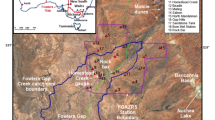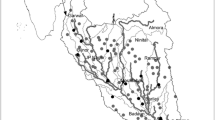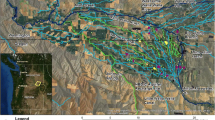Abstract
We quantified the distribution of hillslope runoff under different climate and land-use conditions in a coastal, mixed land-use basin, the Pajaro Valley Drainage Basin (PVDB), California, USA, in order to evaluate opportunities to improve groundwater supply. We developed dry, normal, and wet climate scenarios using high-resolution historic data and compared contemporary land use to pre-development land use under the different climate scenarios. Relative to pre-development conditions, urban and agricultural development resulted in more than twice as much simulated runoff generation, greater spatial variability in runoff, and less water available for recharge; these differences were most pronounced during the dry climate scenario. Runoff results were considered in terms of potential to support distributed stormwater collection linked to managed aquifer recharge (DSC-MAR), which routes excess hillslope runoff to sites where it can infiltrate and enhance groundwater recharge. In the PVDB, 10% of the annual groundwater deficit could be addressed by recharging 4.3% of basin-wide hillslope runoff generated during the normal scenario, and 10.0% and 1.5% of runoff during the dry and wet scenarios, respectively. Runoff simulation results were combined with an independent recharge suitability mapping analysis, showing that DSC-MAR could be effective in many parts of the PVDB under a range of climate conditions. These results highlight the importance of strategically locating DSC-MAR projects at the confluence of reliable supply and favorable subsurface hydrologic properties.





Similar content being viewed by others
References
Ahmadalipour A, Moradkhani H, Demirel MC (2017) A comparative assessment of projected meteorological and hydrological droughts: elucidating the role of temperature. J Hydrol 553:785–797. https://doi.org/10.1016/j.jhydrol.2017.08.047
Allen RJ, Luptowitz R (2017) El Niño-like teleconnection increases California precipitation in response to warming. Nat Commun 8:16055. https://doi.org/10.1038/ncomms16055
Beganskas S, Fisher AT (2017) Coupling distributed stormwater collection and managed aquifer recharge: field application and implications. J Environ Manag 200:366–379. https://doi.org/10.1016/j.jenvman.2017.05.058
Berg P, Wagner S, Kunstmann H, Schädler G (2013) High resolution regional climate model simulations for Germany: part I—validation. Clim Dyn 40:401–414. https://doi.org/10.1007/s00382-012-1508-8
Berne A, Delrieu G, Creutin J-D, Obled C (2004) Temporal and spatial resolution of rainfall measurements required for urban hydrology. J Hydrol 299:166–179. https://doi.org/10.1016/j.jhydrol.2004.08.002
Bouwer H (2002) Artificial recharge of groundwater: hydrogeology and engineering. Hydrogeol J 10:121–142. https://doi.org/10.1007/s10040-001-0182-4
Brocca L, Melone F, Moramarco T (2008) On the estimation of antecedent wetness conditions in rainfall–runoff modelling. Hydrol Process 22:629–642. https://doi.org/10.1002/hyp.6629
Buccola NL, Risley JC, Rounds SA (2016) Simulating future water temperatures in the north Santiam River, Oregon. J Hydrol 535:318–330. https://doi.org/10.1016/j.jhydrol.2016.01.062
Cornelissen T, Diekkrüger B, Bogena H (2016) Using high-resolution data to test parameter sensitivity of the distributed hydrological model HydroGeoSphere. Water 8:202. https://doi.org/10.3390/w8050202
Cvijanovic I, Santer BD, Bonfils C et al (2017) Future loss of Arctic Sea-ice cover could drive a substantial decrease in California’s rainfall. Nat Commun 8. https://doi.org/10.1038/s41467-017-01907-4
Daly C, Halbleib M, Smith JI et al (2008) Physiographically sensitive mapping of climatological temperature and precipitation across the conterminous United States. Int J Climatol 28:2031–2064. https://doi.org/10.1002/joc.1688
Dams J, Nossent J, Senbeta TB et al (2015) Multi-model approach to assess the impact of climate change on runoff. J Hydrol 529:1601–1616. https://doi.org/10.1016/j.jhydrol.2015.08.023
Dillon P (2005) Future management of aquifer recharge. Hydrogeol J 13:313–316. https://doi.org/10.1007/s10040-004-0413-6
Du J, Rui H, Zuo T et al (2013) Hydrological simulation by SWAT model with fixed and varied parameterization approaches under land use change. Water Resour Manag 27:2823–2838. https://doi.org/10.1007/s11269-013-0317-0
Dunne T, Black RD (1970) Partial area contributions to storm runoff in a small New England watershed. Water Resour Res 6:1296–1311
Fang L, Liu C, Qin G et al (2015) Application of the PRMS model in the Zhenjiangguan watershed in the upper Minjiang River basin. Remote Sens GIS Hydrol Water Resour 368:209–214. https://doi.org/10.5194/piahs-368-209-2015
Farjad B, Gupta A, Razavi S et al (2017) An integrated modelling system to predict hydrological processes under climate and land-use/cover change scenarios. Water 9:767. https://doi.org/10.3390/w9100767
Fiseha BM, Setegn SG, Melesse AM et al (2014) Impact of climate change on the hydrology of upper Tiber River basin using bias corrected regional climate model. Water Resour Manag 28:1327–1343. https://doi.org/10.1007/s11269-014-0546-x
Fisher A, Lozano S, Beganskas S et al (2017) Regional managed aquifer recharge and runoff analyses in Santa Cruz and northern Monterey counties. California. https://doi.org/10.7291/V9Q81B7W
Hanson RT, Lockwood B, Schmid W (2014) Analysis of projected water availability with current basin management plan, Pajaro Valley, California. J Hydrol 519:131–147. https://doi.org/10.1016/j.jhydrol.2014.07.005
Hoang L, Schneiderman EM, Moore KEB et al (2017) Predicting saturation-excess runoff distribution with a lumped hillslope model: SWAT-HS. Hydrol Process 31:2226–2243. https://doi.org/10.1002/hyp.11179
Hohmann C, Kirchengast G, Birk S (2018) Alpine foreland running drier? Sensitivity of a drought vulnerable catchment to changes in climate, land use, and water management. Clim Chang 147:179–193. https://doi.org/10.1007/s10584-017-2121-y
Islam A, Sikka AK, Saha B, Singh A (2012) Streamflow response to climate change in the Brahmani River basin, India. Water Resour Manag 26:1409–1424. https://doi.org/10.1007/s11269-011-9965-0
Khaliq MN, Ouarda TBMJ, Gachon P et al (2009) Identification of hydrological trends in the presence of serial and cross correlations: a review of selected methods and their application to annual flow regimes of Canadian rivers. J Hydrol 368:117–130. https://doi.org/10.1016/j.jhydrol.2009.01.035
Kiparsky M, Fisher AT, Hanemann WM, et al (2018) Issue brief: Recharge net metering to enhance groundwater sustainability. Center for Law, Energy, and the Environment, University of California at Berkeley, Berkeley
Leahy PG, Kiely G (2011) Short duration rainfall extremes in Ireland: influence of climatic variability. Water Resour Manag 25:987–1003. https://doi.org/10.1007/s11269-010-9737-2
Liu SC, Fu C, Shiu C-J et al (2009) Temperature dependence of global precipitation extremes. Geophys Res Lett 36. https://doi.org/10.1029/2009GL040218
Liu Y-C, Di P, Chen S-H, DaMassa J (2018) Relationships of rainy season precipitation and temperature to climate indices in California: long-term variability and extreme events. J Clim 31:1921–1942. https://doi.org/10.1175/JCLI-D-17-0376.1
Markstrom SL, Hay LE, Clark MP (2016) Towards simplification of hydrologic modeling: identification of dominant processes. Hydrol Earth Syst Sci 20:4655–4671. https://doi.org/10.5194/hess-20-4655-2016
Markstrom SL, Regan RS, Hay LE, et al (2015) PRMS-IV, Precipitation-Runoff Modeling System. U.S. Geological Survey
Meyerhoff SB, Maxwell RM (2011) Quantifying the effects of subsurface heterogeneity on hillslope runoff using a stochastic approach. Hydrogeol J 19:1515–1530. https://doi.org/10.1007/s10040-011-0753-y
Nauditt A, Birkel C, Soulsby C, Ribbe L (2017) Conceptual modelling to assess the influence of hydro-climatic variability on runoff processes in data scarce semi-arid Andean catchments. Hydrol Sci J 62:515–532. https://doi.org/10.1080/02626667.2016.1240870
Newcomer ME, Gurdak JJ, Sklar LS, Nanus L (2014) Urban recharge beneath low impact development and effects of climate variability and change. Water Resour Res 50:1716–1734. https://doi.org/10.1002/2013WR014282
Page D, Vanderzalm J, Dillon P et al (2016) Stormwater quality review to evaluate treatment for drinking water supply via managed aquifer recharge. Water Air Soil Pollut 227. https://doi.org/10.1007/s11270-016-3021-x
PVWMA (2014) Basin Management Plan Update, Final: February 2014. Pajaro Valley Water Management Agency, Watsonville
Ringleb J, Sallwey J, Stefan C (2016) Assessment of managed aquifer recharge through modeling—a review. Water 8:579. https://doi.org/10.3390/w8120579
Russo TA, Fisher AT, Lockwood BS (2014) Assessment of managed aquifer recharge site suitability using a GIS and modeling. Groundwater 53:389–400. https://doi.org/10.1111/gwat.12213
Santa Cruz County (2016) Santa Cruz County 2016 Crop Report
Shuster WD, Bonta J, Thurston H et al (2005) Impacts of impervious surface on watershed hydrology: a review. Urban Water J 2:263–275. https://doi.org/10.1080/15730620500386529
Swain DL, Langenbrunner B, Neelin JD, Hall A (2018) Increasing precipitation volatility in twenty-first-century California. Nat Clim Chang. https://doi.org/10.1038/s41558-018-0140-y
Tashie AM, Mirus BB, Pavelsky TM (2016) Identifying long-term empirical relationships between storm characteristics and episodic groundwater recharge. Water Resour Res 52:21–35. https://doi.org/10.1002/2015WR017876
Vano JA, Lettenmaier DP (2014) A sensitivity-based approach to evaluating future changes in Colorado River discharge. Clim Chang 122:621–634. https://doi.org/10.1007/s10584-013-1023-x
Yazzie K, Chang H (2017) Watershed response to climate change and fire-burns in the upper Umatilla River basin, USA. Climate 5:7. https://doi.org/10.3390/cli5010007
Zhang X, Cong Z (2014) Trends of precipitation intensity and frequency in hydrological regions of China from 1956 to 2005. Glob Planet Change 117:40–51. https://doi.org/10.1016/j.gloplacha.2014.03.002
Acknowledgments
This project was funded by the California Coastal Conservancy (13-118); the University of California Water Security and Sustainability Research Initiative (449214-RB-69085), supported by the UC Office of the President’s Multi-Campus Research Programs and Initiatives (MR-15-328473); a Graduate Research Fellowship from the US National Science Foundation; the Gordon and Betty Moore Foundation (GBMF5595); and The Recharge Initiative (http://www.rechargeinitiative.org/).
Author information
Authors and Affiliations
Corresponding author
Ethics declarations
Conflict of Interest
The authors declare that they have no conflict of interest.
Additional information
Publisher’s Note
Springer Nature remains neutral with regard to jurisdictional claims in published maps and institutional affiliations.
Electronic supplementary material
ESM 1
(PDF 2.59 mb)
Rights and permissions
About this article
Cite this article
Beganskas, S., Young, K.S., Fisher, A.T. et al. Runoff Modeling of a Coastal Basin to Assess Variations in Response to Shifting Climate and Land Use: Implications for Managed Recharge. Water Resour Manage 33, 1683–1698 (2019). https://doi.org/10.1007/s11269-019-2197-4
Received:
Accepted:
Published:
Issue Date:
DOI: https://doi.org/10.1007/s11269-019-2197-4




